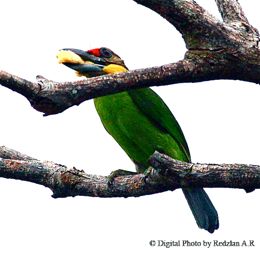In the town of Raub, in Pahang, Malaysia, Muhammad Firdaus Redzlan was observing a Gold-wiskered Barbet (Megalaima chrysopogon) cleaning up a nesting cavity in a trunk of a tree. Young Muhammad informed his father who kept watch the next morning.
The barbet returned to check on the cavity. But before Dr Redzlan Abdul Rahman could record the visit, the bird flew off. He waited for an hour that morning but the barbet did not return. Instead, a pair of Common Flamebacks (Dinopium javanense) arrived and duly inspected the cavity (above: male left, female right).
In the evening Dr Redzlan again kept watch. No barbet. But this time a pair of Javan Mynas (Acridotheres javanicus) came, poked their heads into the hole to inspect it (above). They were probably looking for food. Or were they prospecting for a nesting cavity?
Then late that evening he saw a Gold-wiskered Barbet (probably male) perched high up on the tree with food in his mouth. The bird did not inspect the hole but instead flew off with the food in his bill.
This barbet arrived from the west the next day to perch on the branch of the same tree (left). It rested for a while before proceeding east, always with some yellowish food in his bill. Parent birds normally do not fly directly to its nest to feed the chicks. They always land some distance away, to check whether it is safe to proceed, before flying to the nest. This may be what the barbet was doing.
The cavity appeared to have been abandoned as there was no sign of the barbet visiting it during the following two weeks. But the mynas and woodpeckers kept on checking the cavity.
Many birds are hole nesters but not all such birds are capable of excavating their very own nesting cavities. Only birds like barbets and woodpeckers excavate cavities in old and rotting tree trunks and branches. Others have to make do with natural cavities that develop as the wood rots. Or else depend on second-hand cavities, cavities once used by other birds but now abandoned.
Old and dying trees are never permanent. As they rot, the limbs collapse and eventually even the trunk gives way. Such trees pose a danger to life and limbs, especially around human habitation, so they are routinely removed.
Nesting cavities are thus always in short supply. Competition will always be fierce and some birds even go to the extent of physically removing the residing birds. See HERE for an account of the confrontation between the Long-tailed Parakeet (Psittacula longicauda) and the Dollarbirds (Eurystomus orientalis).
One way to reduce this housing shortage is to provide nest boxes. However, we are way behind the west in the use of and research on nesting boxes. But we have made a start with the Oriental Pied Hornbill (Anthracoceros albirostris).













